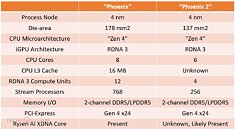- Joined
- Oct 9, 2007
- Messages
- 47,598 (7.45/day)
- Location
- Dublin, Ireland
| System Name | RBMK-1000 |
|---|---|
| Processor | AMD Ryzen 7 5700G |
| Motherboard | Gigabyte B550 AORUS Elite V2 |
| Cooling | DeepCool Gammax L240 V2 |
| Memory | 2x 16GB DDR4-3200 |
| Video Card(s) | Galax RTX 4070 Ti EX |
| Storage | Samsung 990 1TB |
| Display(s) | BenQ 1440p 60 Hz 27-inch |
| Case | Corsair Carbide 100R |
| Audio Device(s) | ASUS SupremeFX S1220A |
| Power Supply | Cooler Master MWE Gold 650W |
| Mouse | ASUS ROG Strix Impact |
| Keyboard | Gamdias Hermes E2 |
| Software | Windows 11 Pro |
AMD has designed a physically smaller version of its 4 nm "Phoenix" mobile processor silicon. The chip could power lower-end mobile SKUs in the Ryzen 3 and Ryzen 5 series, and it's likely that it could make it to Socket AM5, where it will power Ryzen 3 and lower-end versions of Ryzen 5 desktop processors. Built on the same 4 nm foundry process as the standard "Phoenix" silicon, the so-called "Phoenix 2" or "PHX2" die physically features a 6-core/12-thread CPU based on the "Zen 4" microarchitecture, and a physically smaller iGPU with just two WGPs (workgroup processors), or 4 CU (compute units), which work out to 256 stream processors. This iGPU is based on the same RDNA3 graphics architecture as the one powering the regular "Phoenix" silicon. At this point we don't know if the Ryzen AI component gets the axe, but given AMD's enthusiasm with consumer AI acceleration, the die might just retain it.
The PHX2 die likely retains the I/O of the regular "Phoenix," including a dual-channel (4 sub-channel) DDR5 and LPDDR5 memory interface, and a 24-lane PCI-Express Gen 4 root complex. These changes result in a die that appears to be around three-quarters the size of the regular "Phoenix," with an area of around 137 mm², compared to 178 mm² of the regular "Phoenix." The smaller die will save AMD big on costs and yields. At this time, there are at least two processor models reported to be based on this die, the Ryzen 5 7540U and Ryzen 3 7440U. Both are 15 W to 28 W class mobile processors aimed at thin-and-light notebooks.


View at TechPowerUp Main Site | Source
The PHX2 die likely retains the I/O of the regular "Phoenix," including a dual-channel (4 sub-channel) DDR5 and LPDDR5 memory interface, and a 24-lane PCI-Express Gen 4 root complex. These changes result in a die that appears to be around three-quarters the size of the regular "Phoenix," with an area of around 137 mm², compared to 178 mm² of the regular "Phoenix." The smaller die will save AMD big on costs and yields. At this time, there are at least two processor models reported to be based on this die, the Ryzen 5 7540U and Ryzen 3 7440U. Both are 15 W to 28 W class mobile processors aimed at thin-and-light notebooks.


View at TechPowerUp Main Site | Source




